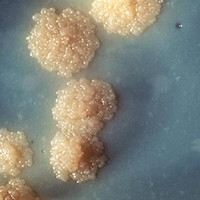Factors associated with time to sputum culture conversion of rifampicin-resistant tuberculosis patients in Klaipeda, Lithuania in 2016-2019: a cohort study

Published: January 14, 2021
Abstract Views: 1262
PDF: 630
Publisher's note
All claims expressed in this article are solely those of the authors and do not necessarily represent those of their affiliated organizations, or those of the publisher, the editors and the reviewers. Any product that may be evaluated in this article or claim that may be made by its manufacturer is not guaranteed or endorsed by the publisher.
All claims expressed in this article are solely those of the authors and do not necessarily represent those of their affiliated organizations, or those of the publisher, the editors and the reviewers. Any product that may be evaluated in this article or claim that may be made by its manufacturer is not guaranteed or endorsed by the publisher.
Similar Articles
- Andrea Passantino, Pietro Guida, Caterina Rizzo, Rosa Carbonara, Roberta Ruggieri, Domenico Scrutinio, Malnutrition in patients admitted to in-hospital cardiac rehabilitation: Clinical correlates and association with mortality , Monaldi Archives for Chest Disease: Vol. 92 No. 2 (2022)
- Cuneyt Tetikkurt, Bahar Kubat, Cigdem Kulahci, Seza Tetikkurt, Buket Caliskaner Ozturk, Assessment score for the diagnosis of a case with pleuroparenchymal fibroelastosis , Monaldi Archives for Chest Disease: Vol. 91 No. 3 (2021)
- Anna Maria Iannicelli, Pasquale De Matteo, Daniele Vito, Elisa Pellecchia, Concetta Dodaro, Francesco Giallauria, Carlo Vigorito, Use of the North American Nursing Diagnosis Association taxonomies, Nursing Intervention Classification, Nursing Outcomes Classification and NANDA-NIC-NOC linkage in cardiac rehabilitation , Monaldi Archives for Chest Disease: Vol. 89 No. 2 (2019)
- Abdulameer A. Al-Mosawi, Hussein Nafakhi, Hadeel K. Hameed, Aortic root diameter, main pulmonary artery diameter/aortic root diameter and pericardial fat volume as predictors of occlusive coronary artery disease , Monaldi Archives for Chest Disease: Vol. 94 No. 2 (2024)
- Oleksandr Korotych, Andrei Dadu, Askar Yedilbayev, Masoud Dara, Operational research as an instrument to address the critical gaps for effective treatment of tuberculosis in eastern Europe and central Asia , Monaldi Archives for Chest Disease: Vol. 91 No. 1 (2021)
- Rafael Martínez-Girón, Liron Pantanowitz, Pulmonary actinomycosis: cytomorphological features , Monaldi Archives for Chest Disease: Vol. 92 No. 2 (2022)
- Simone Salvitti, Elena Repossini, Perception, experience and knowledge of early physiotherapy in intensive care units of Rome: a survey , Monaldi Archives for Chest Disease: Vol. 90 No. 4 (2020)
- Dario Amore, Dino Casazza, Alessandro Saglia, Pasquale Imitazione, Umberto Caterino, Carlo Curcio, How to avoid "en masse" lobectomy using VATS technique in presence of hilar fibrosis , Monaldi Archives for Chest Disease: Vol. 91 No. 2 (2021)
- Federico Piffer, Guido Levi, Giampietro Marchetti, Chiara Barbieri, Immune reconstitution inflammatory syndrome in tuberculous pleurisy and ulcerative colitis: a case report , Monaldi Archives for Chest Disease: Vol. 89 No. 3 (2019)
- Hussein Soleimantabar, Sofia Sabouri, Leila Khedmat, Samira Salajeghe, Behzad Memari, Bahareh Heshmat Ghahderijani, Assessment of CT angiographic findings in comparison with echocardiography findings of chest among patients with aortic arch anomalies , Monaldi Archives for Chest Disease: Vol. 89 No. 3 (2019)
<< < 11 12 13 14 15 16 17 18 > >>
You may also start an advanced similarity search for this article.

 https://doi.org/10.4081/monaldi.2021.1675
https://doi.org/10.4081/monaldi.2021.1675




